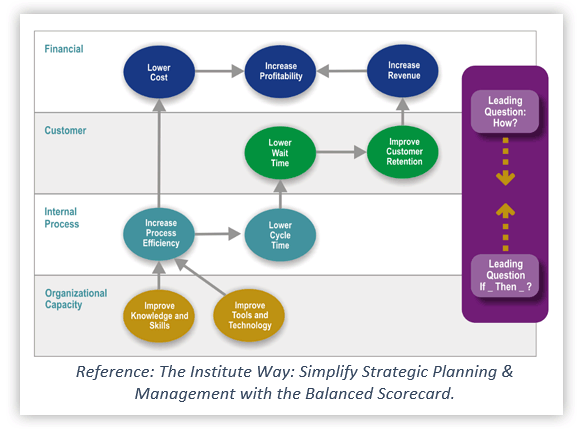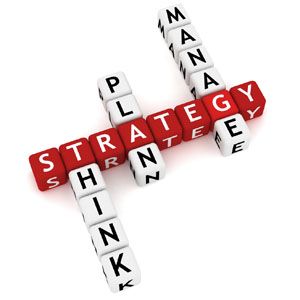About Strategy Mapping
What Is a Strategy Map?
A strategy map is a simple graphic that shows a logical, cause-and-effect connection between strategic objectives (shown as ovals on the map). It is one of the most powerful elements in the balanced scorecard methodology, as it is used to quickly communicate how value is created by the organization.
How Does Strategy Mapping Help an Organization?
Strategy mapping can vastly improve any strategy communication effort. Most people are visual learners and so a picture of your strategy will be understood by many more employees than a written narrative. Plus the process of developing a strategy map forces the team to agree on what they are trying to accomplish in simple, easy-to-understand terms. With a well-designed strategy map, every employee can see how they contribute to the achievement of the organization’s objectives.
What Does a Strategy Map Look Like?
The example below demonstrates how a business might organize their strategic objectives across the four perspectives of the balanced scorecard. Arrows are used to illustrate the cause-and-effect relationship between the objectives. By following the path of the arrows, you can see how the objectives in the lower perspectives drive the success of the higher ones. These causal relationships are central to the idea of strategic planning and management with a balanced scorecard. If you Improve Knowledge and Skills and Improve Tools and Technology (in the Organizational Capacity perspective), you will more easily Increase Process Efficiency and Lower Cycle Time (in the Internal Process Perspective). If you do those things, you will more easily Lower Wait Time, and so on.

This example is a simple teaching example, but a real map will look the same. A typical strategy map will have four perspectives and between 12 and 18 strategic objectives. Like the example above, most for-profit companies put the financial perspective on top because their end goal is to make more money. For public sector organizations, however, finances are more of a means to an end. Since a government or nonprofit’s final goal is to provide the best services it can, it is common for them to switch the top perspectives so that Customer/Stakeholder is on top. Their funding and cost effectiveness (Financial Stewardship) allows them to drive mission-driven success.
How Do You Develop a Strategy Map?
Strategy Map development happens during Step Four of the Nine Steps to Success™. At this point, the organization should have completed a full strategy assessment and developed high level strategy elements like Mission, Vision and Themes/Goals. The organization’s business model will help them choose the right perspective names and order. The mapping process begins when the organization identifies continuous improvement objectives needed to achieve its vision and goals. We recommend objectives that are simple, easy to understand, and that imply continuous improvement. Objectives are identified for all four perspectives and then cause-effect arrows are drawn to indicate the flow of value creation.
Who Develops the Strategy Map?
We highly recommend that cross-functional teams develop all elements of strategy, especially the strategy map. Inclusion in the development process expands the set of viewpoints informing strategy formulation and encourages buy in by the team members that will be responsible for executing the strategy.
How Do I Learn More About Strategy Mapping?
Check out our Balanced Scorecard Professional Certification Program to learn more about Strategy Mapping or the Balanced Scorecard or Contact Us with questions.
Balanced Scorecard Professional Certification

Strategic Planning

Explore Our

Contact us to find out how we can help you take your strategy to the next level!
